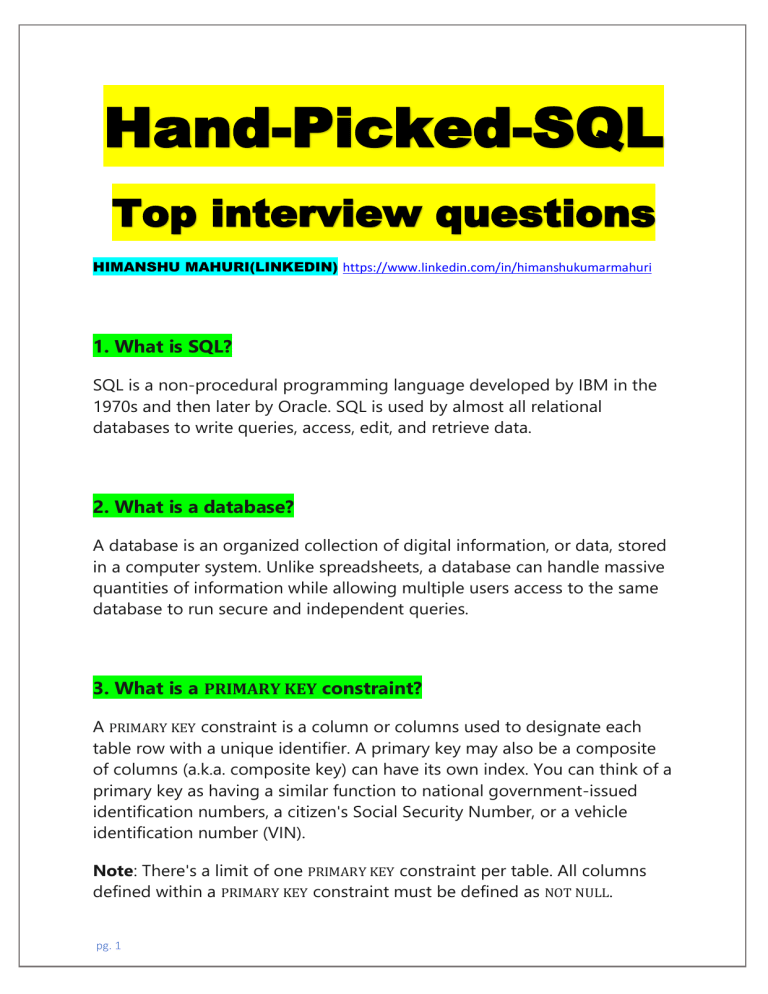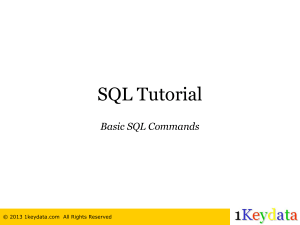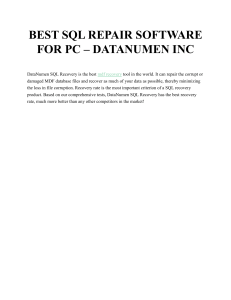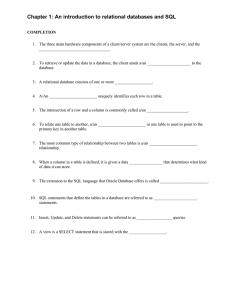
Hand-Picked-SQL Top interview questions HIMANSHU MAHURI(LINKEDIN) https://www.linkedin.com/in/himanshukumarmahuri 1. What is SQL? SQL is a non-procedural programming language developed by IBM in the 1970s and then later by Oracle. SQL is used by almost all relational databases to write queries, access, edit, and retrieve data. 2. What is a database? A database is an organized collection of digital information, or data, stored in a computer system. Unlike spreadsheets, a database can handle massive quantities of information while allowing multiple users access to the same database to run secure and independent queries. 3. What is a PRIMARY KEY constraint? A PRIMARY KEY constraint is a column or columns used to designate each table row with a unique identifier. A primary key may also be a composite of columns (a.k.a. composite key) can have its own index. You can think of a primary key as having a similar function to national government-issued identification numbers, a citizen's Social Security Number, or a vehicle identification number (VIN). Note: There's a limit of one PRIMARY KEY constraint per table. All columns defined within a PRIMARY KEY constraint must be defined as NOT NULL. pg. 1 4. What is an RDBMS, and how is it different from a traditional DBMS? An RDBMS or Relational Database Management System is essentially a database utilizing a tabular schema to organize multiple data elements related to each other. An RDBMS lets your define, create, and maintain relational databases in addition to providing controlled access to the data within. A DBMS or Database Management System functions similarly to the RDBMS described above. However, DBMS data elements are stored as files rather than in tabular form, and there is no relationship between different data elements. 5. Explain the different types of SQL commands. There are six basic types of SQL commands. Type Description Used to create and Data Definition restructure relational Language database objects, such as (DDL) tables. Data Used to manipulate Manipulation data within relational Language database objects. (DML) With only one command, Data Query DQL is used to perform Language queries within a relational (DQL) database. Data Control Used to control access to Language data within a relational (DCL) database. Data Used to analyze database administration operations or conduct commands audits. Transactional Used to manage control transactions within a commands relational database. pg. 2 Commands CREATE TABLE, ALTER TABLE, DROP TABLE, CREATE INDEX, ALTER INDEX, DROP INDEX, CREATE VIEW, DROP VIEW INSERT, UPDATE, DELETE SELECT ALTER PASSWORD, GRANT, REVOKE, CREATE SYNONYM START AUDIT, STOP AUDIT COMMIT, ROLLBACK, SAVEPOINT, SET TRANSACTION 6. What is the difference between SQL and MySQL? SQL is a programming language, while MySQL is a popular, open-source RDBMS. MySQL is used to store and organize data, while SQL is used to access, edit, update and maintain data in MySQL. 7. What is a FOREIGN KEY constraint? A FOREIGN KEY is a column or collection of fields in a table referencing a PRIMARY KEY in another table. The table containing the primary key is known as the parent table, and the table containing the foreign key is called the child table. For example, the PRIMARY KEY in the parent table below is OwnerID. The PRIMARY KEY uniquely identifies individual pet owners. OwnerID LastName FirstName Address PetCount 2498 Smith Bonnie 123 Mango Street 2 2499 Brown Thomas 456 Papaya Way 0 2450 Goes Rosemary 789 Apple Court 1 For this child table, the PRIMARY KEY is PetID, and the OwnerID column is a FOREIGN KEY because it references the primary key of another table. PetID PetName Species OwnerID 1 Whiskers Cat 2450 2 Gilgamesh Cockatiel 2499 3 Enkidu Cockatiel 2499 8. What is a UNIQUE constraint? Like the PRIMARY KEY, the UNIQUE constraint also ensures that each value is different from the others in its column. Tables can have multiple columns with UNIQUE constraints. 9. What are SQL joins? What are the different types of joins? In SQL, a JOIN clause combines rows of data in different tables with a shared column. You can SELECT and return records with matching values in both tables based on this relationship. There are four kinds of JOIN clauses in SQL: pg. 3 JOIN type INNER JOIN Description Returns only the records with matching values in both tables. Returns records in the left table in addition to records with matching values in both tables. Returns records in the right table, in addition to records with matching values in both tables. LEFT JOIN RIGHT JOIN FULL OUTER JOIN or FULL JOIN Returns all records with matches in either the left or right tables. 10. What is a self join? A JOIN clause combines rows from two or more tables based on a related column between them. A self join is a regular join, but the table is joined with itself – this is extremely useful for comparisons within a table. Joining a table with itself means that each table row is combined with itself and with every other row of the table. 11. What is a cross join (Cartesian join)? In SQL, the cross join combines each row of the first table with each row of the second table. It is also known as the Cartesian join since it returns the Cartesian product of the sets of rows from the joined tables. 12. What's the difference between a WHERE clause and a HAVING clause? The WHERE clause can be used to establish the first condition that groups and returns only the rows that meet that condition into a result set. Then, secondary conditions can be applied using the HAVING clause to return only the groups within that set that meet your new criteria. 13. What's the difference between a TRUNCATE command and a DELETE command? Differences Type Function WHERE Transaction logging pg. 4 DELETE TRUNCATE DML (Data Manipulation Language) Used to remove specific rows or tuples from tables or relations. Can contain WHERE clause. DDL (Data Definition Language) Used to delete all rows or tuples from a table. Cannot contain WHERE clause. Deleted data pages are not logged. Row deletions are logged. The TRUNCATE command is faster than DELETE, but unlike the DELETE command, data cannot be rolled back after using it to recover data that has been mistakenly deleted. 14. What are UNION, UNION ALL, MINUS, and INTERSECT set operators? The UNION operation combines the results of two or more SELECT statements. For example, getting the UNION of sets A and B, this operation would return all rows from both sets, excluding any duplicate rows. The UNION ALL operation does the same thing as UNION, but includes duplicate rows in its result set. The INTERSECT operation combines the results of two SELECT statements but only returns the rows with matching values in both sets. The MINUS operation combines the results of two SELECT statements but only returns rows with values that belong to the first set of the result. 15. What is a query? In the context of this article, a query is a set of instructions written in a query language like SQL that allows an individual to access information held in a database. 16. What is a subquery? A subquery or nested query is a query within a query. There are two types of subqueries: Correlated and Non-correlated. • • pg. 5 Correlated subqueries refer to a column in a table specified by the FROM keyword of the main query. Non-correlated subqueries are independent and their output is substituted in the main query. 17. What are Normalization and Denormalization? Normalization refers to the methods used to remove redundancies and inconsistencies in a database. Denormalization refers to methods used to improve the performance of queries. Normalization introduces more tables to a database, whereas Denormalization reduces the number of tables. 18. What are scalar functions? Scalar functions are defined by the user and return a single value (i.e., int, char, float, etc.) based on the input value. Common SQL scalar functions: • • • • • • • concatenates two or more character strings. FORMAT() sets the format to display a collection of values. LEN() calculates the total length of a given column. MID() extracts substrings from a collection of string values. ROUND() rounds the integer value for a numeric field. NOW() returns the current date and time. RAND() calculates a random collection of numbers of a given length. CONCAT() 19. What are aggregate functions? In SQL, aggregate functions (also known as group functions) are applied to a group of values (or all values) to calculate and return a single value. Common SQL aggregate functions: • calculates the average or mean of all values in a group. COUNT calculates the number of rows in group, including rows with NULL values. • MIN • SUM • • • pg. 6 AVG and MAX returns the smallest and largest value in a group, respectively. returns the sum of all non-NULL values in a group. STDDEV calculates the standard deviation. VARIANCE calculates the variance. 20. What is a stored procedure? Instead of writing the same SQL query multiple times, you can save it as a stored procedure and call on it whenever necessary to execute it. Syntax for storing an SQL query: CREATE PROCEDURE procedure_name AS sql_statements GO; Syntax to execute a stored procedure: EXEC procedure_name; 21. What is the SELECT statement? The SELECT statement is used in SQL queries to store specific data elements or fields from a table and return them in a result set. The SELECT syntax: SELECT column_1, column_2, ... FROM table_name; Syntax for selecting all data elements from a table: SELECT * FROM table_name; 22. What is an index? An SQL index is a lookup table used by the database search engine to find and retrieve data quickly. An index can help make SELECT and WHERE clauses faster but can slow down the use of UPDATE and INSERT statements. ] To create an index: CREATE INDEX index_name ON table_name; pg. 7 23. What are some common clauses used with SELECT queries in SQL? The basic SQL SELECT statement contains three clauses: • • • specifies the table columns to retrieve FROM specifies the tables to access WHERE is optional and specifies which rows in the FROM tables to use SELECT The GROUP BY clause is used with aggregate functions to group the result set according to specified columns. The HAVING clause functions similarly to the WHERE clause but allows the use of aggregate functions. The ORDER BY clause sorts the result set in ascending (ASC) or descending (DESC) order according to a specified column. When writing your SELECT queries, make sure that your syntax follows this order: SELECT column_name(s) FROM table_name WHERE condition GROUP BY column_name(s) HAVING condition ORDER BY column_name(s); 24. What is an SQL Server cursor? How do you use it? When you want to process result sets one row at a time, you can use a database cursor, a control structure that allows you to traverse records in a database. Cursors can be used to point to individual rows in a group of rows. You can DECLARE a cursor after any variable declaration. DECLARE variable_name CHAR(20) DECLARE cursor_name CURSOR FOR SELECT column_name FROM table_name pg. 8 26. What are the different types of indexes? • • • • • • Clustered indexes are clustered together with the main body of data. A clustered index sorts and stores rows of data in a table or view sequentially, based on key values of the table to match the order of the index. There can only be one clustered index per table. Non-clustered indexes are separate from, and cannot be used to store or sort data in the main table. The key values of the index, and not the table are used to define the order of a non-clustered index. Column store indexes are a standard form of index that efficiently stores data in a column-based format, rather than row-oriented. Filtered indexes are used to index a section of rows within a table. Hash indexes are arrays, and use the Hash function F(K, N), where K is critical and N is the number of slots containing a pointer and row. Unique indexes assign unique values to every row of data, so that the index key does not contain any duplicates. 27. What is the difference between a clustered index and a nonclustered index? The order of rows in a clustered index corresponds to the order of rows in the database. A table can only have one clustered index at a time. A non-clustered index functions similarly to a clustered index, but is slower and creates a separate entity within the table that references the original table. A table can have multiple non-clustered indices. 28. What are ACID properties? The ACID properties refer to properties that must be followed for transactions in a database management system to remain consistent. • • • pg. 9 Atomicity: The entire transaction takes place at once or not at all. Consistency: A database must be consistent before and after a transaction takes place. Isolation: Transactions occur independently and can run concurrently with others. • Durability: Updates to the database must be stored in and written to disk so that transaction records can persist in the event of a system failure. 29. What is a schema? An SQL schema is an abstract representation of logically structured data elements. Database schemas in SQL are defined at the logical level by a database user known as the schema owner. 30. How do you create empty tables with the same structure as another table? You can use shallow cloning to create a copy of an existing table's data structure and column attributes. CREATE TABLE new_table LIKE table_1; This command creates an empty table based on the parent table. 31. What is the default ordering of data using the order by clause? How could it be changed? The default ordering of data is ascending (ASC). You can change the order by using the descending (DESC) keyword with the ORDER BY clause like so: SELECT * FROM table_name ORDER BY column_name DESC; 32. What is the difference between CHAR and VARCHAR datatypes in SQL? The character or CHAR datatype stores fixed length character strings. The variable character or VARCHAR datatype stores variable length character strings. has better performance than VARCHAR, but VARCHAR can be useful for anticipating data values without a set length. CHAR pg. 10 34. What is the difference between SQL and PL/SQL? SQL is non-procedural and interacts directly with the database server. It's easy to learn and use, but if you need to solve more complicated SQL problems and are willing to learn some more complex concepts, then PL/SQL can be a powerful tool. PL/SQL is a procedural language that doesn't interact directly with the database server but offers a faster processing speed and an expanded range of supported features. You can accomplish everything you need to do in SQL and more using PL/SQL. PL/SQL: • • • Can be used to write functions, packages, procedures, program blocks, and more. Supports for variables, conditional statements, and iterators. Supports error and exception handling. • 35. What are entities and relationships? An entity can be a real-world object that can be identified by a collection of related attributes or properties. An example of an entity in a zoo database might include zookeepers, veterinarians, different public outreach initiatives, or species of animals. Relationships are connections between entities that are associated with each other. The logical relationship between entities creates a database. SOURCE-Internet HIMANSHU MAHURI(LINKEDIN) https://www.linkedin.com/in/himanshukumarmahuri pg. 11



